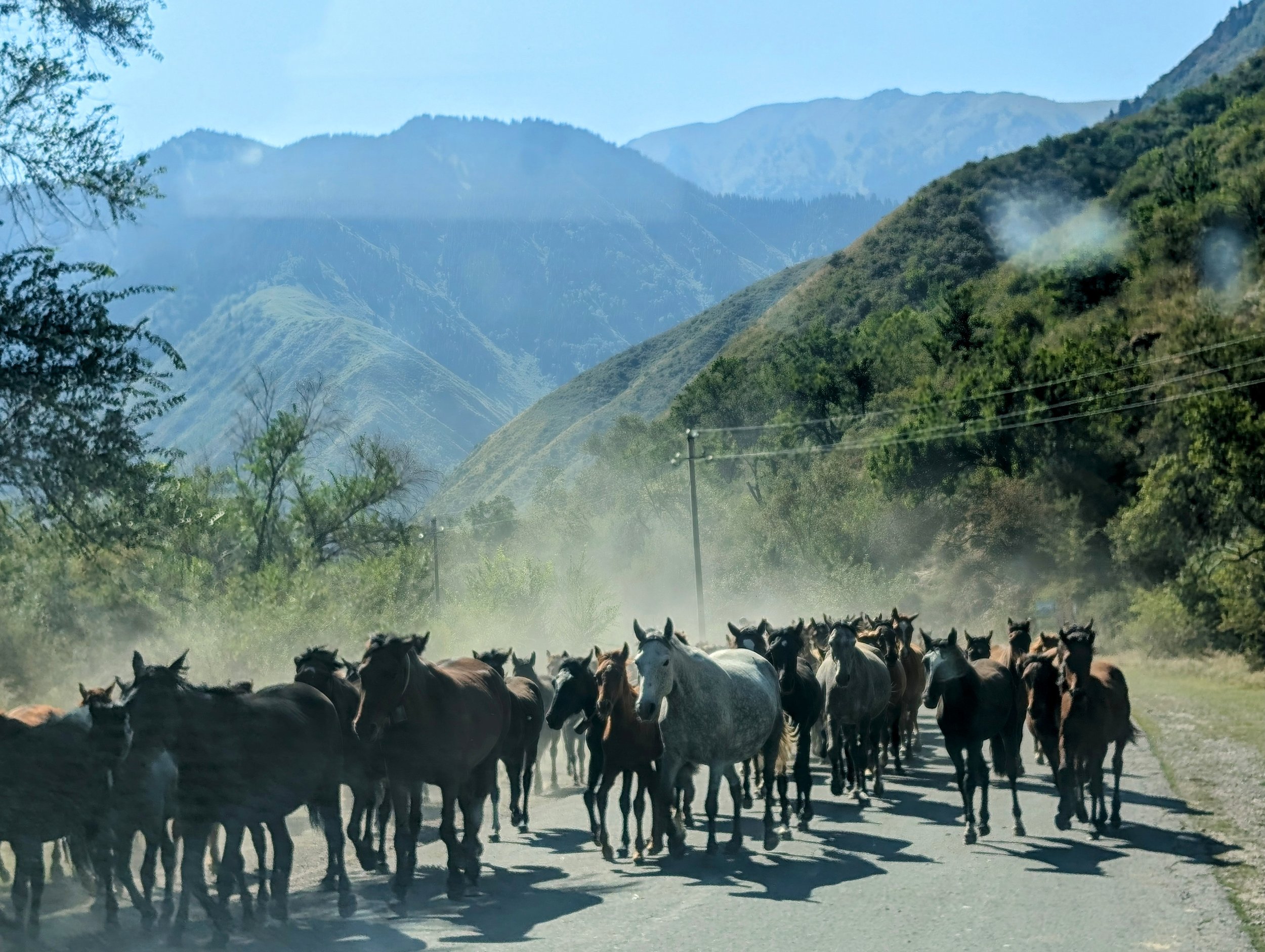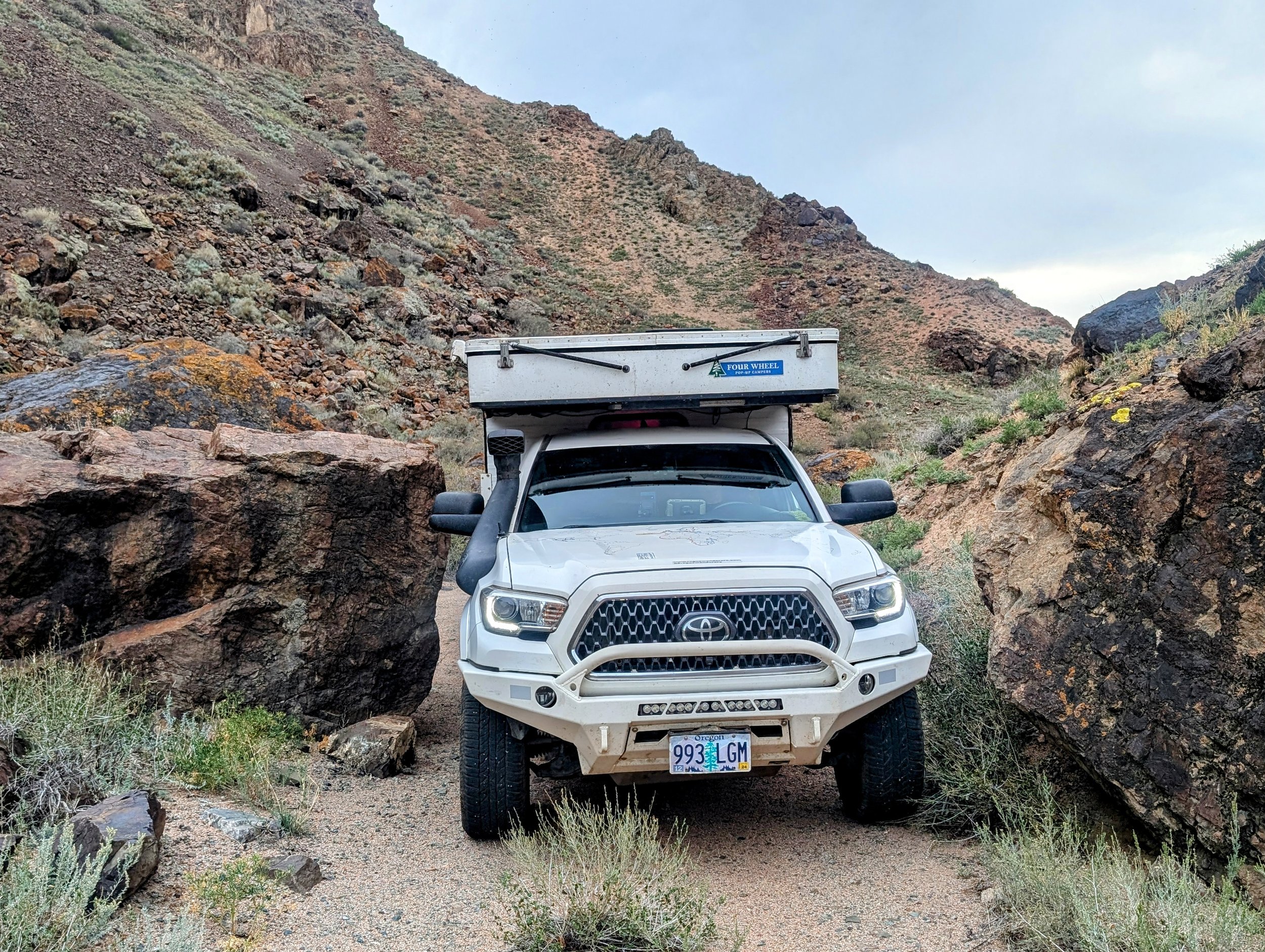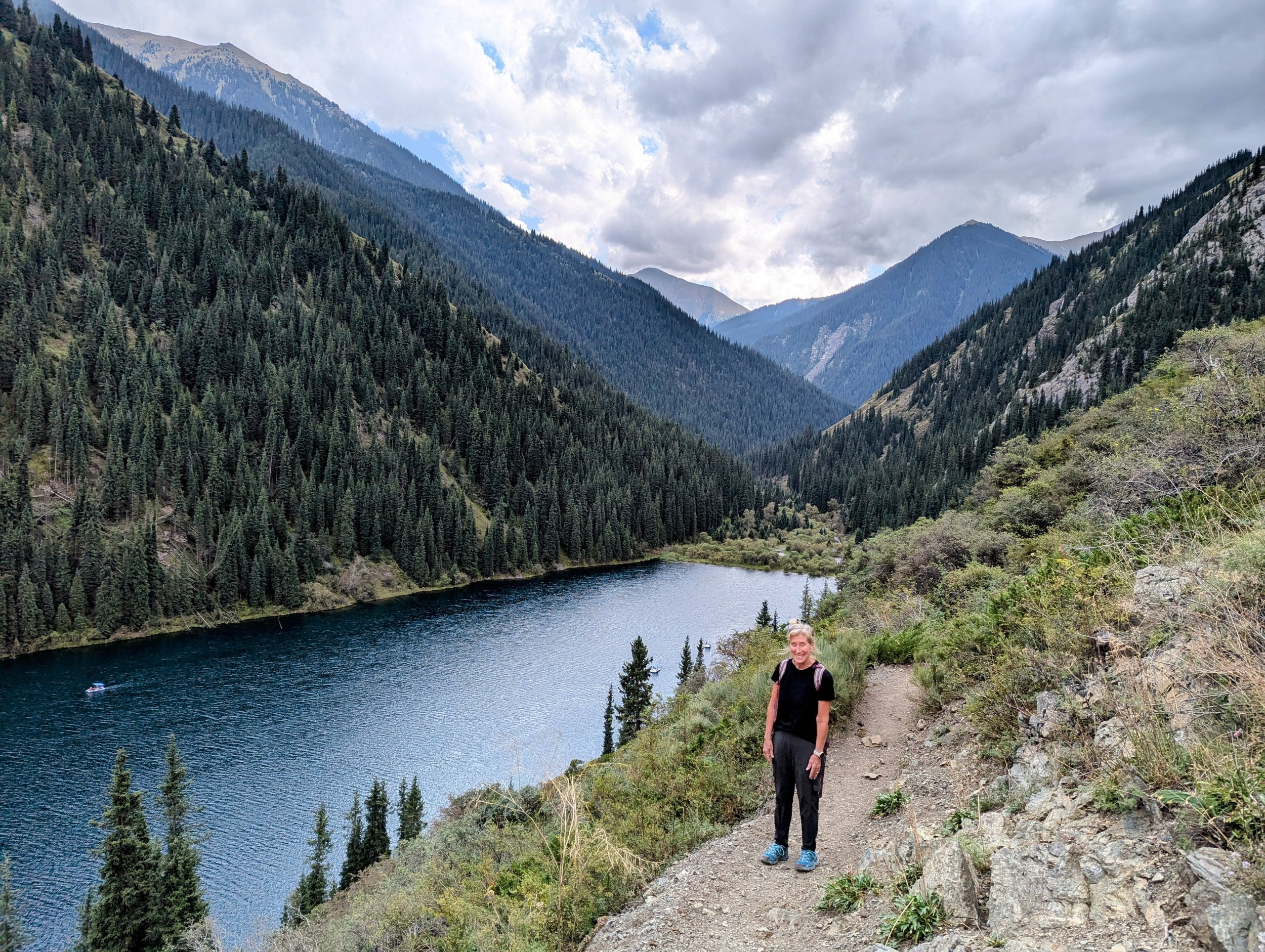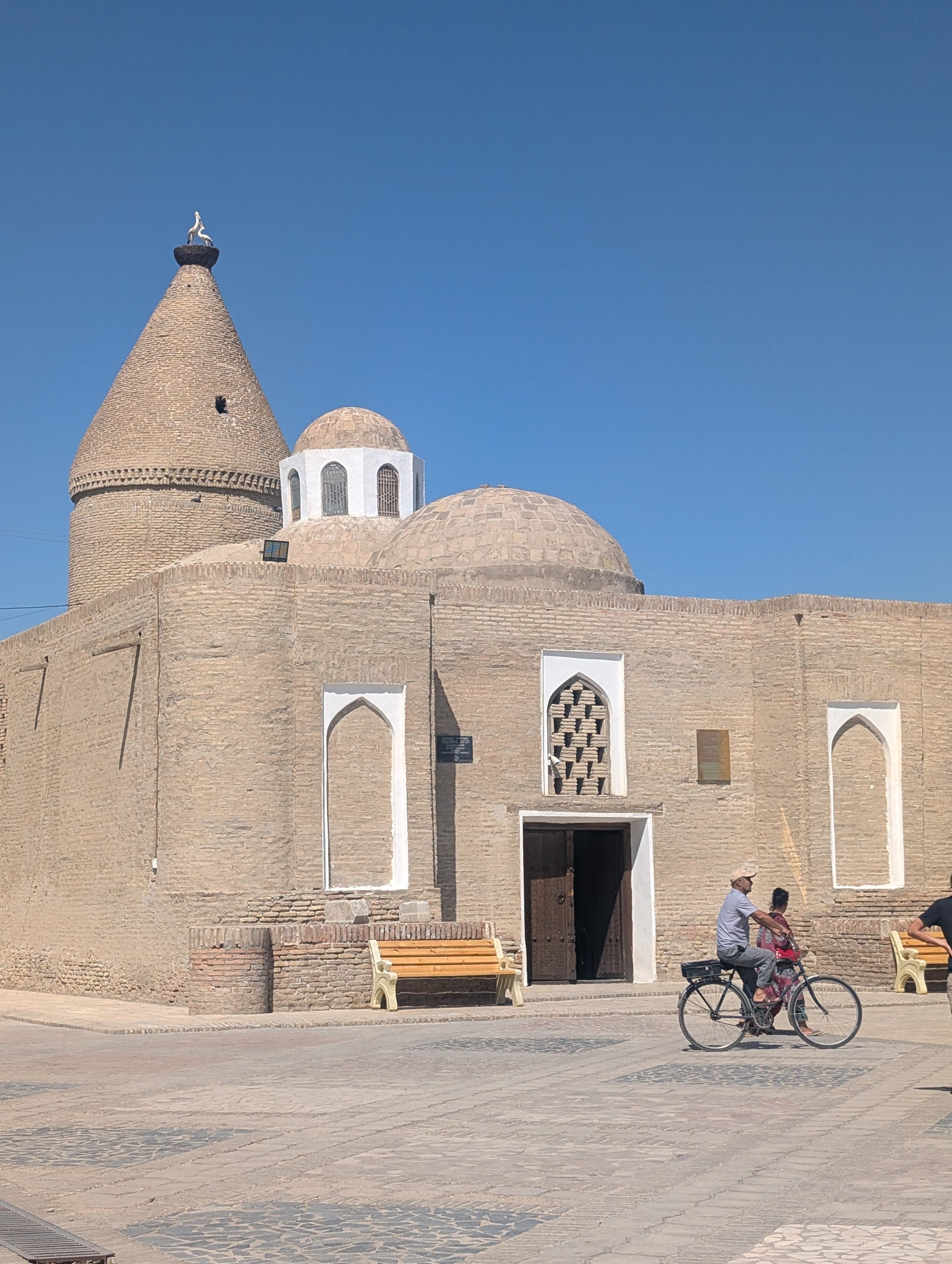Kazakhstan and Uzbekistan
Ancient Silk road fort of Janbasqala in Uzbekistan
The Silk Roads
Driving the Silk Roads had been a lifetime dream of ours. There is a mystique that surrounds the idea of retracing the ancient steps of these early explorers, merchants and warriors. We listened to historical accounts in the truck as we learned about the early East-West trading routes, what they meant to the world, seeding centuries of conflict and the beginning of commercial globalization. The names of Marco Polo and Genghis Khan evoked exotic images of camel trains loaded with silk and spices making their way across the desert. We could not wait to take our own journey along these venerable routes.
Our 3 week, 3600 km route
The trip was well worth the wait. Each country we visited had its own personality and culture, but there were also many similarities shared by the countries often lazily referred to as “the Stans.” People were uniformly welcoming, curious and hospitable. Although little English was spoken, especially among the 40+ populace whose second language is Russian, people still wanted to communicate with us - using a lot of universal hand gestures and often Google Translate. Food and resources were easy to find on this first part of the route and the general lack of people in vast landscapes made wild camping easy. We paid for water once, but found clean free sources the rest of the month. We never paid for camping. Similar to the Arabian Peninsula, our expenses plummeted, down to an average of $60 per day for the two of us, as our main expense, gas, was generally cheap and food was less expensive than most other places we have traveled. Our route meandered in and out of countries, but we have separated each country in the blogs to make it easier (for us!).
Kazakhstan
Our first country, Kazakhstan, was in many ways what we expected of the area- initially lots of hot dry steppes. But as we made our way north, we were surprised by the transition to lush fields, forested national parks with lakes and rivers and eventually, mountains.
Our first two-humped camel siting! The Bactrian camel - native to the Central Asian steppes.
Our entry involved a (very) long border crossing - something we would get used to. Even when the line seemed short (9-10 cars) - border crossings in the region often took 4-5 hours. Processes were unclear and confusing and, as we were unable to speak local languages, took some deciphering. Luckily there were often kind locals who took pity on us and showed us the way. Usually we felt like we were on some kind of confusing bureaucratic scavenger hunt as we would be handed a slip of paper that required multiple officials in different buildings and offices to stamp. We learned to clarify upfront how many stamps we needed before we could leave so we would not be sent back. Car searches were relatively thorough and involved drug sensing dogs and often X ray scans. Luckily we do not carry any contraband so there was no stress involved, just a lot of patience needed.
Although we had a Carnet de Passage at this point, we did not use it in the Stans. Kazakhstan customs issued us a Temporary Import document for the truck, and as US citizens we did not need visas so paperwork was free. We were also easily able to buy auto insurance ($40 for a month) from a booth at the border.
Camped just over the border into Kazakhstan from Russia - woke up to "wild" life all around.
It was time to re-supply the truck so we stopped off in Atyrau, a pleasant city on the Ural river. The city displayed much of the Soviet era architecture common in the region as the Russian and then the Soviet empire maintained primary control from the late 18th century through 1991.
Walking the riverfront promenade
Ural riverfront - high rises and fishermen
Grocery shopping took much longer here. The language and alphabet is completely unknown to us. Although some words and pictures were intuitive, we have learned in the past to doublecheck with Google Translate (Dawn has been known to accidentally buy sour cream instead of milk for her coffee - a disaster that spoiled her morning in more than one way).
Kazakh spice aisle - very confusing for Dawn
As was trying to figure out how to weigh the produce!
Grateful for pictures - but it still took Dawn 30 minutes to accurately weigh 10 bags of produce - and she got two wrong to the amusement of the register clerk. (One picture of potatoes looks a lot like another)
The bakery items looked fabulous but it was a case of buying mystery fillings
MANY varieties of sausages and hot dogs. . . .
Grocery cabinets and fridge full, we made our way into the great empty steppes. Camping was no problem - just drive as far away from the main road as you feel like.
Our first proper night wild camping in the steppe
The next morning Andy decides it is time to change the oil
Oops - picked up a screw in the tire somewhere along the way but this kind tire shop owner fixed it for us - and then went ahead and rotated the tires.
Andy's new friends at the tire shop. The constant dusty winds in the region meant many people opted for facial scarves.
The first time we have paid for water in 4 years (last time was eastern Romania on our way to Moldova). Since it was the middle of the desert, we did not mind joining the commercial water tanker at the filling station and paying the equivalent of $1 to fill our tank.
We had researched in advance and learned that road safety in Kazakhstan was serious business. Police are out and patrolling, equal opportunity fines are applied for any offender who exceeds the speed limit or passes on a solid line. Andy was scrupulous about following the rules and we never had a problem. (Unlike the previous week in Russia where corrupt police attempted to shake us down for $300 for a made up “offense.” In that case, Andy refused to pay, joked around with them and built camaraderie and eventually they let us go). What we had heard about the police in Kazakhstan was true in our experience, they are strict but honest and even handed in applying the rules.
When there wasn't real police there was fake police
And fake farm animals
Our first cultural experience in Kazakhstan was visiting Turkestan. The beautiful architecture was awe inspiring. The Persian inspired tile work, Arabic script and signature blue dye originally imported from Mongolia was magnificent.
Mausoleum of Khawaja Ahmed Yasawi, Turkic poet and Sufi mystic, commissioned in 1389 by Timur.
The back side was equally impressive but never finished
Common road view in Kazakhstan
Then we were back on the road, covering some distance. After a few days in the dry steppes, we were ready for some green. We drove through the city of Almaty (modern but lots of traffic!) and made our way out to Ile Alatau National Park.
Visiting the Sunkar Falconry Center to learn more about this ancient regional art, humans working closely with birds of prey to hunt.
After visiting the falcon center (a little gimmicky, but still interesting) we camped inside the national park along the river. There are convenient flat spots along the river, free to camp and cement pads for cooking safely.
Riverside camp in Ile-Alatau National Park
Valley views along the hike to the lake
We decided to hike in to Lake Almaty - a classic hike in the park. Much of it was along a paved road servicing local communities
A SIDEBAR- SECURING OUR INDIAN VISAS
We are very grateful to the ongoing information sharing in a variety of Whatsapp and Facebook travel forums we belong to. We were getting new information that the Indian Embassy in Islamabad was becoming more tricky to work with in securing visas. This had always been our plan so as we heard of people waiting for weeks for visas in Islamabad and often being declined we decided to figure out a Plan B. As US Citizens, it was relatively simple for us to apply online for one-year multi-entry visas. The trick was that these “E-visas” were not valid for a land border entry, only for airports. However, once you fly into India and have the visa stamped into your passport, you are then allowed to enter at a land border.
So we flew in one day, roundtrip from Almaty to Delhi, Indian E-visas in hand to get them stamped in our passports so that we could continue our journey east.
It was a 3am start in Almaty but there were already lines, luckily for Dawn there was also already coffee for sale
Previewing the mountains we would later drive through by air
And an 8 hour layover at the airport in Delhi before we could return. Dawn trying her best to look alert, somedays even coffee doesn't work.
The next leg of our journey figured out, we returned to exploring Kazakhstan’s beautiful natural sites..
Wild camp along the way - tucked into the trees
It was fall and shepherds were busy bringing livestock down from the mountains to more temperate climates before winter comes
We shared the road
Our next stop was beautiful Turgen Gorge, it felt far removed from the vast steppes and reminded us of our home in Oregon with rolling hills, trees and beautiful rivers. Infrastructure was minimal but we used our Gaia app to find a trail and set off.
Beginning of Turgen Gorge hike. Sign was impossible for us to read, but it made us feel like we were going the right way.
Sketchy bridge. We like the fact that in this region a high level of common sense is assumed, people are expected to take responsibility for their own safety whether hiking or driving. (Rarely do you see a flagger or safety cones for road hazards here)
Excited to see our first yurt!
Local spring we used to fill our water tank
Winding our way through dry hills. In general southern Kazakhstan was not nearly as flat as we thought it would be.
Heading onto a track to find a wild camping spot at the edge of Charyn Canyon
Squeezing through rocks along the way - glad we decided not to go with the F150
Not sure where we will end up but liking the scenery and the journey
The final task when pulling into camp - leveling, sometimes with the aid of objects found around camp.
Gorgeous! One of the joys of overlanding, finding that unique, remote soul filling spot where you just look around and soak it up
As we got higher in elevation, yurts became more common, typically nomadic shepherds homes.
Our final real stop in Kazakhstan was Kolsai Lakes National Park. It was stunning, but surprisingly crowded. During our time in Kazakhstan most of the tourists we encountered were local or from neighboring countries, people would give us a second look, smile and ask where we were from. We felt like welcomed outsiders. Kolsai Lake was beautiful but our first instinct was to set off on a hike away from the instagram photo posing, coffee drinking, paddle boating crowds.
Kolsai Lake
We started on what we thought was a trail around the lake and quickly left all the people behind. We soon saw why, our two hour hike turned into a four hour expedition. Once we left the boardwalk, the trail disintegrated, taken over by tree fall, requiring clambering up and down steep cliff banks and a few unexpected water crossings.
The final leg when we rejoined the developed trail. Dawn is tired.
Overall Kazakhstan was an incredibly easy introduction to the region, travel logistics were easy to figure out and the friendliness and engaging nature of the people made it feel safe and comfortable wherever we went.
Hay loads become major road obstacles
Our final night in Kazakhstan, camped near the border in a field with mountain views.
Fall is coming, a cloudy morning for a border crossing
Our only prep for Uzbekistan was filling our Rotopax as we had heard about gas shortages. This turns out to have been very exaggerated, fuel was relatively easy to find with planning ahead and filling up in urban areas.
Discovered a leaky cap so employed a bush fix learning in Africa - seal with a plastic bag under the cap
We left Kazakhstan happy about our first “stan” country experience, ready to see what Uzbekistan had to bring.
Approaching the border with Uzbekistan
Uzbekistan
Uzbekistan felt like an even greater step back in history. The architecture in the cities was some of the most beautiful we have seen. We were back to desert and loved being able to clamber around old silk road forts on our own, using our imaginations to fill in the gaps.
Unfortunately, Uzbekistan also had some of the worst roads - the kind of crumbling asphalt with unexpected craters coming out of nowhere that made driving feel like a pinball course. This was made worse by seeing, as we entered, miles and miles of new highway newly completed but not yet accessible for vehicles. Definitely driving will be easier in the near future!
It was another slow border crossing (5 hours) despite the fact that there were only a few cars ahead. The most frustrating part about the borders was just waiting outside a gate for the guards to decide to let vehicles in, often for hours with no knowledge of what to expect for the timeline. Sometimes commercial trucks were being prioritized, sometimes it seems that people were either on a break or changing shifts. We learned to be prepared with food, water and kindles loaded with books. But in the end we were easily issued another Temporary Import permit for the truck (this time $2 fee), entry was free for us as US citizens and auto insurance was only $10.
However, there was some additional bureaucracy for Uzbekistan tourists. All tourists are required to be registered by an official accommodation (hotel or hostel) within a few days of arrival. You are also required to have a certain number of “proof of stay” receipts which are entered into a national database and examined upon exiting the country. The rules seemed to be a little vague, we asked repeatedly and the best guidance we got was that you should be registered “about a third” of your days in the country. Luckily, hostels were accustomed to people needing registration and many would complete the paperwork for you for about $5 per person whether or not you actually stayed there.
Our first night in Uzbekistan - camped in an empty staging area for the new road construction - not our most glamorous site but very quiet.
Beautiful above ground cemeteries dotted the landscape, with intricately designed mausoleums
A very brave car load . . .
Our second night, camped in the sandy desert
Our first cultural stop in Uzbekistan was city of Nukus and the Savitsky Museum. Nukus itself was unremarkable, a Soviet built city with broad avenues and practical architecture. But the museum was fascinating, with great value added by our young, local tour guide. Named after a Russian benefactor committed to preserving Uzbekistan art, the museum houses an impressive collection which rotates regularly. The art gives an intriguing insight into the life and historical culture of the country.
Early 20th century piece by O. Tansiqbaev
Women picking tulips
Then back to traveling the desert
Next up was a real Silk road experience - the land of 50 fortresses or Elliq Khala in Khorezm. Built in the 6th to 4th centuries BC, these ancient forts have mostly and remarkably stood the test of time. Some have had some partial renovation, others are slowly eroding into the sand.
Even our stamina could not withstand 50 fortress visits so we spent most of our time at three.
Standing on the walls of Topraz Kala
Brick walls and openings at Topraq Kala. Both a defensive fort and a royal residence, the site once housed over 2500 people and is one of the best preserved Kushan Empire (Indo-European people driven west by the Chinese) sites in Central Asia.
Dawn looking for the best angle to capture the extensiveness of Topraq Kala. A Unesco site, some of the walls in the distance are restored.
Her final picture
The next site was Ayaz Qala, with three forts spread over neighboring hills, dating back to the 4th century BC.
Driving up to the smaller fort at Ayaz Qala
Following a rough path outside the walls
Finding pottery shards everywhere. It was so incredible to be the only people wandering these places.
Looking from the small fort site across the valley to the larger site
First views of Janbasquala, our third and final fort, rising out of the desert
Walls of mud brick slowly crumbling away
Double walls with tunnels inbetween
Our fort explorations over, time to hit the road and see some ancient Silk road cities. Of all the countries we went to in the region, the historical cities of Uzbekistan were our favorite. Khiva, Bukhara and Samarkand were extraordinary, blending unique and intricate ancient architecture with contemporary conveniences.
Camel on the road photo - it never gets old.
More desert
Sandy wild camp along the way - found some shade!
Although heavily renovated and somewhat touristy, the city of Khiva charmed us. Walking its streets, we could feel and sense what it must have been like to live there in times gone by. Our only glitch was that Google Maps did its best to navigate us into a non-driving area to get us to the hotel we had booked. Finally we realized we needed to park outside the gates and walk in - which actually positively added to the overall atmosphere of the city.
Walking in between the inner and outer walls of Khiva
Gorgeous old doors
Beautiful mural
The city felt like a living museum blending art and architecture
We appreciated the fact that unlike some ancient walled cities, people still actually lived in Khiva
We enjoyed a local performance in the town square, equally transfixed by our fellow local tourists as by the performers themselves
Beautiful mosaic work everywhere
And down the side streets, people living their lives
Uzbeki weaving
Our first meal out in Uzbekistan - yummy savory bread pies and kebabs
Khiva was equally beautiful at night
Outside the walls of Khiva
Our next historic city was Bukhara. Feeling the need for another hotel registration, we camped outside a hostel close to the city center.
Our urban camping spot in Bukhara
Visiting the neighborhood baker for breakfast
After the relative quiet of Khiva, Bukhara felt like a bustling metropolis. Tourists and locals filled the streets, gaping in awe at the beautiful old architecture and conducting daily business. Although much of the city was destroyed when Genghis Khan invaded in 1220, remnants of those days remained along with some beautiful newer architecture.
Bolo Hauz Mosque, built in the early 1700's
Mausoleum built over the reputed site of Job's Well - where he struck the ground with his staff and created a well.
Central market - and more of the classic regional flat bread
And a whole room of cheese balls
Mausoleum of Ismail Samani. The oldest remaining building in Central Asia, it dates back to the 9th century. Not destroyed by Genghis Khan as it was buried under sand when he came through.
Beautiful Modarikhon Madrasah, school built in the 16th century
Central plaza of Old Bukhara city
Kalon Tower - from the 12th century. Competing stories for why Genghis Khan did not destroy it: 1) he looked up to the top and his hat fell off which made him bend to pick it up and he commented that never before had a structure force him to bow to it. 2) he liked throwing his enemies to their death off of it
Our last stop in Uzbekistan was Samarkand, a key Silk road trading center and one of the oldest continuously inhabited cities in Central Asia. Not as touristy as Khiva or Bukhara, the old buildings were surrounded by pleasant walking paths, parks and contemporary cafes and shops.
Mausoleum of the ruler Timur, built in the 15th century
The women of Uzbekistan typically wore light weight colorful cotton fabrics and head scarves.
Central Registan square in Samarkand
Hazrat Khizr Mosque, Samarkand
Beautifully carved and painted ceilings
A local lunch of Plov - rice cooked with vegetables and meat, a staple
And samsas, delicious meat filled pastries
And for Dawn, no visit to the region was complete without learning more about making rugs. We visited the Samarkand Bukhara Silk Carpet factory for an excellent tour, demonstration and explanation of the process.
Silk cocoons
Artist hand knotting a silk rug from naturally died silk. It can take several years to complete a rug.
Two artists working together on a complicated pattern
And of course, we had to buy one. We could not afford silk (averaging $15,000!) but found a great wool one.
Our tour guide, son of the factory owner
Throughout Uzbekistan young people enjoyed taking pictures with us
That is it for our first two Central Asian Stan countries - a resounding success for us in terms of increasing our world knowledge and developing our remote travel skills. Thank you for reading and hope you come along on the next leg of our journey with us!


































































































































